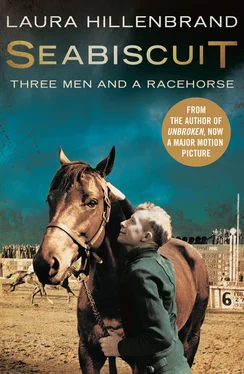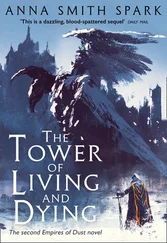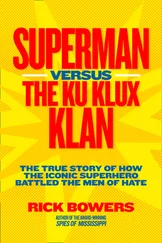1 ...7 8 9 11 12 13 ...25 The colt was practically sneering at him. Smith was standing by the track rail, weighing the angles and gestures of low-level horses as they streamed to the post, when a weedy three-year-old bay stopped short in front of him, swung his head high, and eyed him with an arch expression completely unsuited to such a rough-hewn animal. “He looked right down his nose at me,” Smith remembered later, “like he was saying, ‘Who the devil are you?’ ” Man and horse stood on opposite sides of the rail for a long moment, sizing each other up. An image materialized in Smith’s mind: the Colorado ranges, a tough little cow horse. The pony boy leading the colt to the post tugged him on his way. Smith watched the animal’s rump swing around and go. Thin, yes, but he had an engine on him.
Smith flipped to the horse’s profile in the track program. The colt was a descendant of the mighty Man o’ War through his sire, the brilliantly fast, exceptionally handsome Hard Tack, but his stunted build reflected none of the beauty and breadth of his forebears. The colt’s body, built low to the ground, had all the properties of a cinder block. Where Hard Tack had been tall, sleek, tapered, every line suggesting motion, his son was blunt, coarse, rectangular, stationary. He had a sad little tail, barely long enough to brush his hocks. His stubby legs were a study in unsound construction, with squarish, asymmetrical “baseball glove” knees that didn’t quite straighten all the way, leaving him in a permanent semicrouch. Thanks to his unfortunate assembly, his walk was an odd, straddle-legged motion that was often mistaken for lameness. Asked to run, he would drop low over the track and fall into a comical version of what horsemen call an eggbeater gait, making a spastic sideways flailing motion with his left foreleg as he swung it forward, as if he were swatting at flies. His gallop was so disorganized that he had a maddening tendency to whack himself in the front ankle with his own hind hoof. One observer compared his action to a duck waddle. All of this raggedness was not helped by his racing schedule. His career had been noteworthy only in its appalling rigor. Though only three years old, he had already run forty-three races, far more than most horses contest in their entire careers.
But somehow, after throwing a fit in the starting gate and being left flat-footed at the bell, the colt won his race that day. While being unsaddled, he leveled his wide-set, intelligent eyes on Smith again. Smith liked that look, and nodded at the horse. “Darned if the little rascal didn’t nod back at me,” Smith said later, “kinda like he was paying me an honor to notice me.” He was a horse whose quality, an admirer would write, “was mostly in his heart, and Tom Smith had been the first to recognize it.” A man for whom words were encumbrances, Smith didn’t take note of the horse’s name, but he memorized him nonetheless. He spoke to the horse as he was led away.
“ I’ll see you again.”
The horse’s name was Seabiscuit, and for a bent-backed trainer on the other side of the backstretch, the brief exchange of glances between the horse and Tom Smith was the beginning of the end of a long, pounding headache. In 1877, when James Fitzsimmonswas three, the Coney Island Jockey Club annexed his family’s Brooklyn neighborhood and literally built a track around his house, leaving it standing in the infield while the racing world revolved around it. “Sunny Jim,” as admirers called him, was thus entangled in the racetrack from the beginning of his conscious life. He never escaped it. “All I ever wanted to do,” he once said, “was be with the horses.” At age ten he worked as a dishwasher in the track kitchen. He moved on to a harrowing career as an exercise boy, then became a jockey. “I was vaccinated for jockey,” he liked to say, “but it didn’t take.” He survived a rocky reinsman’s career, then hung it up to try his hand at training. He had found his niche.
Fitzsimmons soon established himself as the most successful conditioner of Thoroughbreds in the nation. That June he was sixty-one and imprisoned in a body so ravaged by arthritis that his upper spine was slowly collapsing forward, driving his head so far downward that in time he would have to learn to identify his horses solely by their feet. He coaxed a phenomenal amount of work out of his rigid body, laboring so hard over his horses through the week that he had to sleep straight through Sunday to recover. The work paid off: Fitzsimmons had cultivated the talents of myriad champions, including Gallant Fox and Omaha, two of the first three horses to sweep the Kentucky Derby, Preakness Stakes, and Belmont Stakes—the Triple Crown. His greatness was beyond question. His was a household name across America, and trainers regarded him with profound reverence. Tom Smith was no exception. Fitzsimmons was apparently the only man whom Smith ever regarded with awe.
The events that brought the two trainers together had begun in 1928, when Fitzsimmons was entrusted with the two-year-old Hard Tack, sire of the colt Smith would see at Suffolk Downs. Owned by Gladys Phipps and her brother Ogden Mills, operators of the East’s legendary Wheatley Stable, Hard Tack was a copper-colored paragon of symmetry, grace, and blinding speed. Everything about him was superlative, including his single flaw: He was uncontrollable. The characteristic had surfaced, to a greater or lesser degree, in nearly every horse to descend from his great-grandsire, Hastings, a thousand-pound misanthrope for the ages. On the track, where he won races as prestigious as the 1896 Belmont Stakes, Hastings deliberately rammed and attempted to maul his competitors. Off the track, he ripped groom after groom to ribbons. “He went to his death unreconstructed and unloved,” wrote Peter Chew in American Heritage magazine, “having left his mark literally and figuratively on many a stablehand.” Hastings passed both speed and malevolence down to his son Fair Play, who in turn bequeathed it to his incomparable son, Man o’ War. Racing in 1919 and 1920, this immense red animal so devastated his competition that he won by as many as one hundred lengths and set numerous speed records. Man o’ War lost only once in his career—to a colt coincidentally named Upset—a defeat that still ranks among the most shocking in sports history. 1Arguably the greatest runner who ever lived, Man o’ War became a prolific sire, populating the racing world with beautiful man-eaters.
A typical example was War Relic. While a youngster, he acquainted the world with his jolly personality by stomping a groom to death. His trainer, Culton Utz, tracked down leading jockey Tommy Luther, famed for his fearlessness and ability to stay aboard even the most unrideable beasts, and brought him to the training farm to work with the horse. Luther was appalled at just how bad the colt was. “The horse,” remembered Luther, “would do everything wrong.” Luther and Utz put War Relic through endless hours of patient schooling until they felt he was ready to go to the track without killing anyone. At Rhode Island’s Narragansett Park they entered him in a race. War Relic displayed cherubic behavior, grabbed the lead out of the gate, and never relinquished it, winning with consummate ease. “Next time he runs,” Luther told his wife, Helen, “bet a hundred dollars. It will be like taking candy from a baby.”
Helen did as her husband asked, then sat in the stands on race day, terrified and praying. War Relic rocketed to the lead, held it around the track, and flew into the homestretch all alone. Luther thought his $100 bet was going to cash in. But War Relic had been an angel for exactly one and three quarter races, and he was pushing his limits. As the crowd cheered him on from the grandstand, he abruptly bolted to the inside, hit the rail, and stopped dead, vaulting Luther into a spiraling dive directly toward the toothy track harrows parked in the infield. Luther was on the verge of being skewered. Throwing out his hands, he caught the rail, swooped around it like a gymnast, and made a clean dismount onto the track. Steward Tom Thorpe walked across the course and stared at Luther’s uninjured body, incredulous.
Читать дальше











